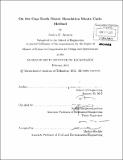| dc.contributor.advisor | Nicolas Hadjiconstantinou. | en_US |
| dc.contributor.author | Armour, Jessica D | en_US |
| dc.contributor.other | Massachusetts Institute of Technology. Computation for Design and Optimization Program. | en_US |
| dc.date.accessioned | 2012-09-13T18:57:32Z | |
| dc.date.available | 2012-09-13T18:57:32Z | |
| dc.date.copyright | 2012 | en_US |
| dc.date.issued | 2012 | en_US |
| dc.identifier.uri | http://hdl.handle.net/1721.1/72863 | |
| dc.description | Thesis (S.M.)--Massachusetts Institute of Technology, Computation for Design and Optimization Program, February 2012. | en_US |
| dc.description | "February 2012." Cataloged from PDF version of thesis. | en_US |
| dc.description | Includes bibliographical references (p. [73]-74). | en_US |
| dc.description.abstract | This thesis develops and evaluates Gap-tooth DSMC (GT-DSMC), a direct Monte Carlo simulation procedure for dilute gases combined with the Gap-tooth method of Gear, Li, and Kevrekidis. The latter was proposed as a means of reducing the computational cost of microscopic (e.g. molecular) simulation methods using simulation particles only in small regions of space (teeth) surrounded by (ideally) large gaps. This scheme requires an algorithm for transporting particles between teeth. Such an algorithm can be readily developed and implemented within direct Monte Carlo simulations of dilute gases due to the non-interacting nature of the particle-simulators. The present work develops and evaluates particle treatment at the boundaries associated with diffuse-wall boundary conditions and investigates the drawbacks associated with GT-DSMC implementations which detract from the theoretically large computational benefit associated with this algorithm (the cost reduction is linear in the gap-to-tooth ratio). Particular attention is paid to the additional numerical error introduced by the gap-tooth algorithm as well as the additional statistical uncertainty introduced by the smaller number of particles. We find the numerical error introduced by transporting particles to adjacent teeth to be considerable. Moreover, we find that due to the reduced number of particles in the simulation domain, correlations persist longer, and thus statistical uncertainties are larger than DSMC for the same number of particles per cell. This considerably reduces the computational benefit associated with the GT-DSMC algorithm. We conclude that the GT-DSMC method requires more development, particularly in the area of error and uncertainty reduction, before it can be used as an effective simulation method. | en_US |
| dc.description.statementofresponsibility | by Jessica D. Armour. | en_US |
| dc.format.extent | 74 p. | en_US |
| dc.language.iso | eng | en_US |
| dc.publisher | Massachusetts Institute of Technology | en_US |
| dc.rights | M.I.T. theses are protected by
copyright. They may be viewed from this source for any purpose, but
reproduction or distribution in any format is prohibited without written
permission. See provided URL for inquiries about permission. | en_US |
| dc.rights.uri | http://dspace.mit.edu/handle/1721.1/7582 | en_US |
| dc.subject | Computation for Design and Optimization Program. | en_US |
| dc.title | On the Gap-Tooth direct simulation Monte Carlo method | en_US |
| dc.type | Thesis | en_US |
| dc.description.degree | S.M. | en_US |
| dc.contributor.department | Massachusetts Institute of Technology. Computation for Design and Optimization Program | |
| dc.identifier.oclc | 808366749 | en_US |
